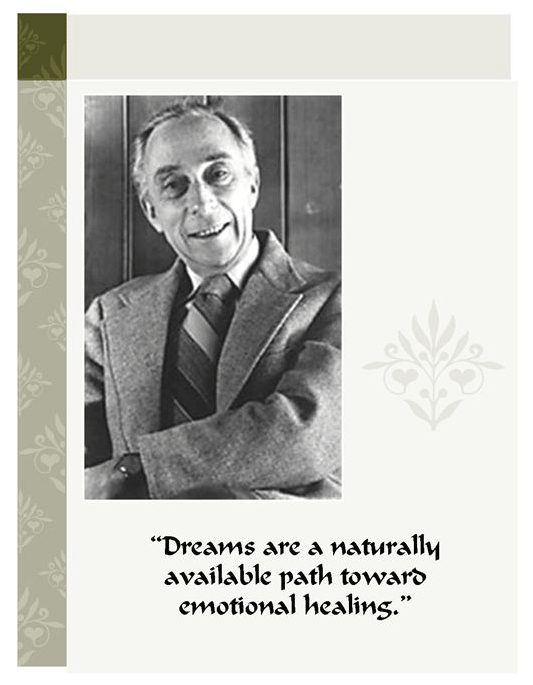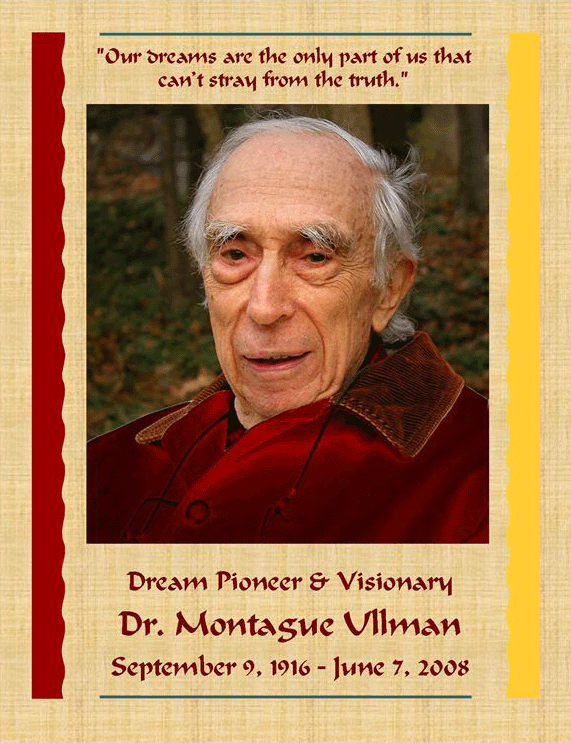Meet Dr. Montague (Monte) Ullman
 |
About Monte Ullman:
Monte was above all else
a humanitarian with a passion for species connectedness
and healing. This passion came to the fore in his
research and theoretical findings. Holding degrees in
neurology and psychiatry, he used his background in
neurology to understand the brain function of dreaming.
He was an intellectual who furthered the dream work of
Freud and Jung. As Jung advanced the work of Freud,
Ullman enlarged on Jung’s archetypes and the collective
unconscious by proposing that dream images have
metaphorical meaning unique to the individual and thus
created a revolution in the way dreams had been
perceived for most of the last century. He likened dream
images to metaphors in motion describing them as
animated expressions of our true emotions creating the
opportunity for emotional growth.
Following his life-long quest to understand the enduring
mystery of dreams, he developed an experiential dream
group process in 1961 that he continued to develop,
practice and teach throughout his life. In so doing he
liberated the process of dream work expanding it beyond
the consulting room out into the community so that all
people could experience a sense of connectedness. His
process inspired his dream workers to continue his work,
by either writing theses, preparing articles or forming
dream groups on subjects such as Dreams and Aging,
Dreams and The Deaf, and Dreams and Aids. Monte used his
approach to dreams in counseling 911 survivors; he
taught the clergy the use of dreams in marriage
counseling, helped therapists to utilize dream work in
private practice with their patients and motivated
professionals to apply his approach to dream work to
psychohistorical research and dissertations.
Monte received his
gratification from healing and paid little heed to
recognition or prominence. An extremely modest man with
a philanthropic nature, he often worked for a minimal
fee or pro bono with his patients, and later, with his
dream group leaders.
Monte Ullman’s Evolution
His career began as a 14
year old boy with a fascination in parapsychology,
consciousness and immortality. He and a group of
youngsters engaged in Saturday night sittings for a two
year period and the boys believed they received evidence
from a Dr. Bindelof, purportedly a physician whose
mission was to heal. These sittings were documented in
his paper entitled “The Bindelof Story.” Upon entering
medical school, he continued to pursue these interests
by seriously engaging in the study of the human mind.
Having established a Community Mental Health Center at
Maimonides Medical Center in Brooklyn, he set up the
first sleep and dream laboratory in the United States
conducting experiments on the physiology of dreaming and
possible evidence of telepathic consciousness in
dreaming.
Monte
devoted his life to lecturing, teaching and inspiring a
grassroots dreamwork movement which began in the United
States and Sweden and has now spread worldwide. Invited
to Sweden to train psychiatric medical students in
dreams in the mid-1970s, he continued to make biannual
trips to that country for much of the next three decades
to train medical residents and others in his methods.
The professional organization Drömgruppsforum [Dream
Group Forum] founded founded in Sweden in 1990 was
followed in 2003 with the Dream Group Forum in Finland.
This was the culmination of Monte’s work in training
groups there, and is widely used in psychotherapy
practices throughout Sweden and Finland, devoted to the
practice and training in Ullman experiential dream work
methods. This widespread movement afforded him the
ability to see the differences in dreams across cultural
and national boundaries. Monte is the subject of the
2006 documentary “Catch the Dream.” His book,
Appreciating Dreams: A Group Approach, was
translated into Chinese and is being used as a medical
textbook in a number of Taiwanese universities
Monte Ullman’s career
which began with parapsychology, advanced to medicine
(neurology and psychiatry), led to a fascination with
dreaming consciousness and telepathy, and ultimately
arrived at a relationship of dreaming to quantum
physics. This step by step progression harkened back to
heightened states of consciousness and the question of
consciousness surviving bodily death, reflecting back on
his experiences in the Bindelof sittings. Monte, seeking
answers beyond his own field of psychiatry, was drawn to
physicist David Bohm’s theory of the implicate order, an
order of wholeness that includes a theoretical melding
of various levels of consciousness, including dreaming
and waking consciousness. He found that the
connectedness experienced in dream group work was a
feature of Bohm’s implicate order. Expanding on Jung’s
collective unconscious, Monte referred to the universal
unconscious.
Synthesis
Many of
Monte’s theories about the idiosyncratic nature of dream
imagery and the role that dreams play in the absence of
external stimuli were developed based upon decades of
observation in conducting and leading his specialized
experiential dream work process in small groups and
training therapeutic professionals and laypeople in the
Ullman methodology. While disseminating his method, he
was simultaneously forming his theories centering on the
analogous nature of dreaming and waking consciousness.
These theories were later borne out in neuroscientific
studies in the electronic activity of the brain during
REM sleep.
The results of the
Ullman-inspired experiential movement gave rise to an
unprecedented evolution in dream ideology towards the
“demystification” of dream work, and an upsurge in
popular interest in dreams. Monte spent the last 30
years of his life developing a theory on the
relationship of dreaming consciousness to quantum
physics. His interdisciplinary contributions in
psychology, dream research and neurology covered a range
of intellectual bases.
The dreamwork movement pioneered by Montague Ullman
fostered public and scholarly attention to dreams,
reflecting and supporting the cognitive revision taking
place in the culture at large. Amassed over the past
century, Montague Ullman's body of work is monumental in
its significance as a primary source that advances an
atheoretical approach for the study of dreams and
dreaming consciousness into the 21st century, while
honoring and expanding upon the notable theories of
Freud and Jung.
|
 |
|

